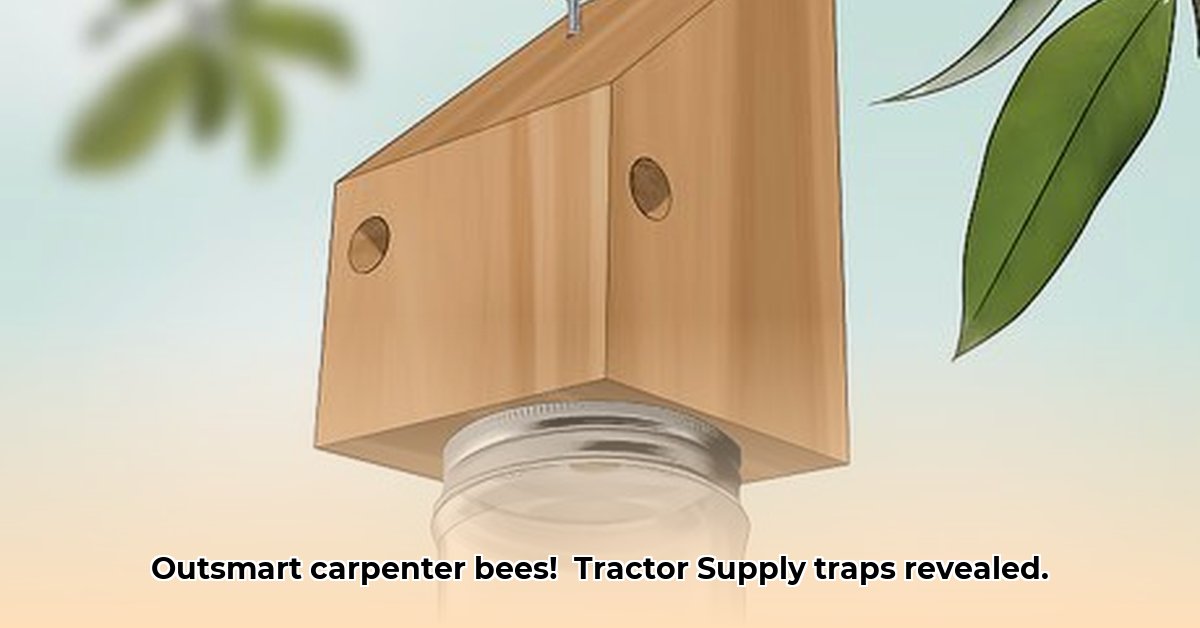
Carpenter Bee Traps at Tractor Supply: A Buyer's Guide
Carpenter bees: those buzzing insects that can quickly turn your prized wooden structures into riddled honeycombs. Don't despair! This guide will equip you with the knowledge to effectively combat these pests using traps readily available at Tractor Supply. We'll explore various trap types, their pros and cons, and provide a step-by-step guide to successful implementation. We’ll also discuss environmentally conscious strategies, ensuring you can protect your property while minimizing harm to beneficial insects. For more options, check out other fly traps at Tractor Supply.
Understanding Your Trap Choices at Tractor Supply
Choosing the right carpenter bee trap is crucial for effective pest management. Think of it like selecting the right tool for a job – a screwdriver won't hammer a nail, and a simple trap might not suffice for a large infestation. While specific Tractor Supply models aren't listed here, we'll examine common trap types you might encounter.
Trap Type A: The Simple Trap
- Description: Typically a straightforward design, often made of plastic or mesh, ideal for smaller infestations or beginners. Generally inexpensive and easy to set up.
- Pros: Budget-friendly, simple assembly and maintenance, requires minimal effort.
- Cons: Lower capture rate compared to more robust traps, may need frequent replacement.
- Hypothetical User Review: "Easy setup, good for a small area, but I had to replace it after a month."
Trap Type B: The Heavy-Duty Trap
- Description: A more robust design, possibly constructed from wood or metal, suitable for larger infestations. May be larger and incorporate attractants to lure bees.
- Pros: Higher capture rate, better for significant infestations, potentially includes attractants for enhanced effectiveness.
- Cons: More expensive, requires more frequent emptying and cleaning, necessitates greater maintenance.
- Hypothetical User Review: "A lifesaver! I had a massive bee problem, and this trap significantly reduced the population in a few weeks."
Trap Type C: The Targeted Trap
- Description: Utilizes specific scents or lures to attract carpenter bees, providing a more targeted approach.
- Pros: Highly effective due to the attractant, potentially a more humane option as it primarily targets carpenter bees.
- Cons: More expensive, attractant may require regular replacement, might not be universally effective across all bee species.
- Hypothetical User Review: "Very impressed! The lure attracted a large number of bees."
Choosing the Right Trap: Matching Your Needs
Selecting the perfect trap involves considering several key factors:
- Budget: Trap prices vary significantly. Balance cost with effectiveness based on the scale of your problem.
- Infestation Size: A minor infestation might only need a basic trap, while a widespread problem necessitates a larger, more efficient solution.
- Location & Accessibility: Choose a trap easily placed and maintained near the affected areas. Consider the wood type and accessibility for effective trap placement.
- Maintenance Level: Consider the time commitment involved in emptying and cleaning. Some traps demand more frequent attention.
Setting Up and Using Your Trap: A Step-by-Step Guide
Successfully deploying a carpenter bee trap involves strategic placement and consistent maintenance. Follow these steps:
- Strategic Placement: Position the trap near observed carpenter bee activity; shaded areas are often effective.
- Baiting (If Necessary): Follow the manufacturer's instructions if your trap uses bait or an attractant.
- Regular Monitoring: Check your trap regularly to remove captured bees and ensure its cleanliness. A full trap is less effective.
- Safety First: Always wear gloves when handling the trap and its contents to minimize the risk of stings.
Environmental Considerations: Responsible Pest Management
While dealing with carpenter bee infestations, remember their role in the ecosystem. Consider sealing existing holes and cracks in wooden structures to prevent future infestations, reducing your reliance on trapping. Exploring natural deterrents may offer a complementary approach, but further research into their effectiveness is needed. A balanced approach minimizes environmental impact while resolving the bee problem.
Disclaimer
The effectiveness of carpenter bee traps varies based on factors like infestation size, trap design, and weather conditions. Always use traps safely and responsibly, following instructions carefully. Results may vary.